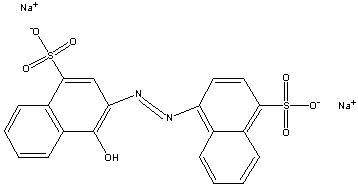
NTP Study Reports

NTP Study Reports
Home » Study Results & Research Projects » NTP Study Reports » All Long-Term Reports » Abstract for TR-220 C.I. Acid Red 14

| Chemical Formula: C20H12N2O7S2·2Na | - | 3D Structure* |
|---|---|---|
| *To view structure, download free Chemscape Chime Plug-in | ||
A carcinogenesis bioassay of textile grade C.I. Acid Red 14 (67%-71% purity) was conducted by feeding diets containing 6,000 or 12,500 ppm of this dye for 103-104 weeks to groups of 50 male F344 rats, 12,500 or 25,000 ppm to groups of 50 female F344 rats, and 3,000 or 6,000 ppm to groups of 50 B6C3F1 mice of either sex. Groups of 90 untreated rats of either sex and 50 untreated mice of either sex served as controls.
Throughout the study, mean body weights of dosed rats of either sex and dosed female mice were comparable with those of the controls, while the mean body weight of high-dose male mice was slightly lower than that of the controls.
Fourteen male rats in the low-dose group and 2 in the high-dose group accidentally drowned between weeks 84 and 103; 56% and 60% of these groups survived to terminal kill compared with 78% of the controls. These losses may have reduced the sensitivity of the assay in male rats.
Rats and mice may have tolerated higher doses, but the slight depression of mean body weight in high-dose male mice and the non-neoplastic lesions observed in dosed female mice and in rats of both sexes suggest that doses administered in this study could be considered maximum tolerated doses.
Endometrial stromal polyps of the uterus were observed in high-dose female rats at an incidence significantly higher (P=0.008) than that seen in the controls (controls: 9/87, 10%; low-dose: 11/50, 22%; high-dose: 14/50, 28%). However, the observed incidence of this tumor in the dosed groups was similar to the historical rate in untreated female F344 rats at this laboratory (65/286, 23%; range 10%-37%). Hence, the increased incidence of this lesion is not regarded as being associated with the administration of C.I. Acid Red 14.
Administration of C.I. Acid Red 14 to mice was not associated with an increased incidence of any tumor type.
Under the conditions of this bioassay, C.I. Acid Red 14 was not carcinogenic for F344 rats or B6C3F1 mice of either sex.
Levels of Evidence of Carcinogenicity: | ||
| Male Rats: | Negative | |
| Female Rats: | Negative | |
| Male Mice: | Negative | |
| Female Mice: | Negative | |
Synonym: 4-hydroxy-3-(4-Sulfo-1-naphthalenyl)azo-1-naphthalenesulfonic acid, disodium
Report Date: March 1982
Target Organs & Incidences from 2-year Studies
You may link to the full technical report in pdf format ( Note: A print ready copy of the document is presented in Portable Document Format (pdf) which requires the Acrobat Reader plug-in -- download a free copy of the reader.)
Web page last updated on October 14, 2004
The National Institute of Environmental Health Sciences is one of the National Institutes of Health within the U.S. Department of Health and Human Services. The National Toxicology Program is headquartered on the NIEHS campus in Research Triangle Park, NC.